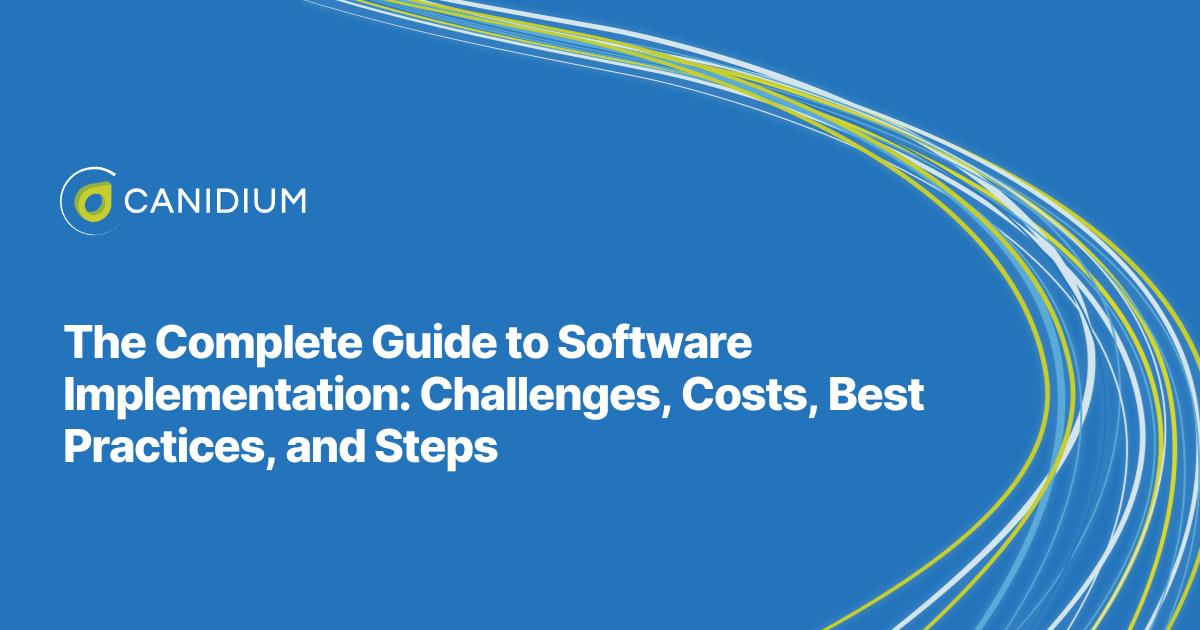Receiving a lowball implementation estimate does not seem like a bad thing at face value. You want to minimize investment costs in a new solution, so a small implementation bill aligns with this goal. However, lowball implementation estimates come with hidden fees often exceeding what you would have otherwise paid a more diligent partner.
Our software implementation (SI) teams at Canidium leverage their extensive experience in the field to provide realistic and accurate estimates. We understand the consequences of inaccurate project forecasting and lackluster discovery processes. We have helped clients overcome the aftermath of lowball estimates before.
This article will explain the four problems caused by lowball estimates and the warning signs to look out for to help you avoid these types of partnerships.
4 Problems With Lowball Implementation Estimates
Each software implementation project is unique, so the consequences you may face due to a lowball estimate may be singular. However, there are four overarching problems that companies face as a result of a lowball estimate.
.png?width=1920&height=1080&name=Im%20(6).png)
The way these four issues manifest can take a variety of formats, so to fully understand the potential long-term implications of a lowball ball estimate, here is a breakdown of the individual consequences.
1. Added Costs
If a project is under-scoped—meaning your SI partner overlooked critical elements and potential complexities—you will likely face an onslaught of change requests as the project progresses. These additional costs not accounted for in the original Scope of Work (SoW) can drastically inflate your total expenditure.
For instance, imagine being quoted $200,000 for a project only to find yourself spending $500,000 because your SI partner inaccurately assessed the scope at the outset. This scenario is frustrating; it can lead to significant professional repercussions, including job terminations for those deemed responsible for the oversight.
The allure of a lowball estimate often comes with hidden trade-offs in quality and expertise. The lowest bids might come from newer, less experienced providers who lack the proven track record of successfully handling complex implementations. While established companies with extensive portfolios might charge more, they bring a depth of experience and reliability that can prevent costly delays and quality issues.
When you opt for the lowest bid without scrutinizing the provider's credentials and the estimate's comprehensiveness, you risk paying much more in the long run, especially if you have to switch SI partners. Quality, experience, and thorough scope of work come at a cost. Still, they are often worth the investment to avoid unexpected financial burdens.
2. Timeline Delays
Be cautious when you receive a project estimate that significantly undercuts others—especially regarding the timeline. A common consequence of accepting such lowball estimates is severe delays in project completion. For example, a project your SI partner initially promised to complete in four months might take over a year and a half. This discrepancy often arises because they underestimate the scope, leading to continuous adjustments and change requests that prolong the project indefinitely.
The scenario typically unfolds when the provider, having submitted a low estimate, realizes the actual work surpasses the forecasted effort and cost. As they scramble to align reality with their commitment, the project suffers. Ramp-up times increase if the team is not involved in the initial solution design, adding further delays. Rebuilding or correcting earlier phases of the project due to a lack of foresight or expertise also contributes to timeline extensions.
Suppose your SI partner bases the estimate on a time-and-materials contract. In that case, this should alert you to potential inaccuracies in the project's timeline and scope. Providers may use this strategy to secure the business, planning to cover costs through extended timelines and additional fees.
When an estimate of cost and time seems too good to be true, it likely is. The risk of delayed completion escalates, impacting the budget and strategic outcomes dependent on the project's timely delivery.
3. Project Management Issues
When you receive a project estimate that seems surprisingly low, it might be because the provider plans to use all offshore resources. While this can reduce the initial cost, it introduces several project management challenges that could affect the project's overall success. One significant issue is managing time zone differences. Coordinating between teams spread across various time zones can lead to delays in communication and decision-making, complicating the management process.
The complexity of an implementation project can also be exacerbated by cultural differences and language barriers. Misunderstandings or misinterpretations can result in errors or the need for rework, which delays project milestones and can inflate costs beyond the original estimates.
4. Degraded Product Quality
The adage "You get what you pay for" is particularly relevant here. A lowball estimate often means that the quality of the final product might not meet your expectations or the standards required for successful implementation.
Lower bids can result from using less experienced staff or cutting corners in essential processes, which can directly impact the quality of the work. Experienced providers with a track record of delivering hundreds of successful implementations often charge more. This cost reflects their expertise, reliability, and assurance that the project will meet quality standards.
When multiple vendors offer bids for the same project, and one comes in unusually low, it is crucial to scrutinize why this is the case. Often, a lower cost indicates that your SI partner may allocate fewer resources to the project or employ less thorough methods. This lack can lead to a buggy final product that does not fully meet the project specifications or requires further adjustments post-delivery.
Ultimately, opting for the lowest bid without considering the broader implications can lead to significant additional costs in terms of rework, delays, and lost business opportunities due to subpar project outcomes. It is essential to balance cost considerations with the quality and reliability of more experienced providers.
The Warning Signs of Lowball Implementation Estimates
Pinpointing which estimates are lowballs can be tricky if you have received various quotes. However, there are a few telltale signs to keep an eye out for:
- Lack of Details: When you encounter a project estimate that seems suspiciously low, it is crucial to pay attention to the details—or the lack thereof. Suppose an estimate skims over the specifics of what will be delivered, only providing vague descriptions of what they will do. In that case, you should see this as a red flag. A detailed breakdown of the services and materials is fundamental for any credible estimate.
- Missing Project Governance Elements: Another telltale sign of a risky lowball estimate is the absence of project governance elements. These include oversight mechanisms, regular touchpoints, and essential documentation that should accompany the delivery process. Proper governance is likely lacking if your SI partner does not explicitly spell out these components in the estimate. This oversight ensures the project stays on track and meets the agreed standards and timelines.
- Unrealistic Project Timeline: Consider the project timeline proposed in the estimate. A significantly shorter project duration than other estimates can be a warning sign. It might indicate that the service provider underestimates the work's complexity or scale required. For example, suppose one vendor offers to complete the job in eight weeks while others propose 18 or 24 weeks. In that case, this discrepancy should raise concerns about the feasibility and realism of the faster timeline.
- Reliance on Change Requests: Be wary of scenarios where a low estimate relies on change requests to bridge the gap between the low initial cost and the actual expense required to complete the project. This approach can cost much more in the long run, leading to significant delays and frustrations.
Remember, if the estimate lacks detail, skips governance processes, proposes an unreasonably short timeline or significantly undercuts other bids without clear justification, these are all warning signs that the estimate might not be optimistic but unrealistically low. Such estimates can lead to project failures and the need for significant corrective actions down the line.
Pay closer attention to details like reference calls to understand a potential SI partner's track record; this will ensure you can fully leverage their expertise during implementation.
The Consequences of Lowball Implementation Estimates
Lowball estimates lead to additional costs, timeline delays, project management issues, and a lower-quality outcome later on. These factors constitute hidden costs that often lead to a higher total bill in the long term.
Avoiding these issues is paramount when selecting an SI partner, so review your estimate to ensure that it is detailed, realistic in terms of timeline and costs, and contains the proper governance elements. Contacting your prospective partner's references can also help you gauge their reliability.
With this understanding of the important role of your SI partner in the implementation process, your next step is to choose between your quotes. Read on to learn more about weighing your options when it comes to SI partners.








